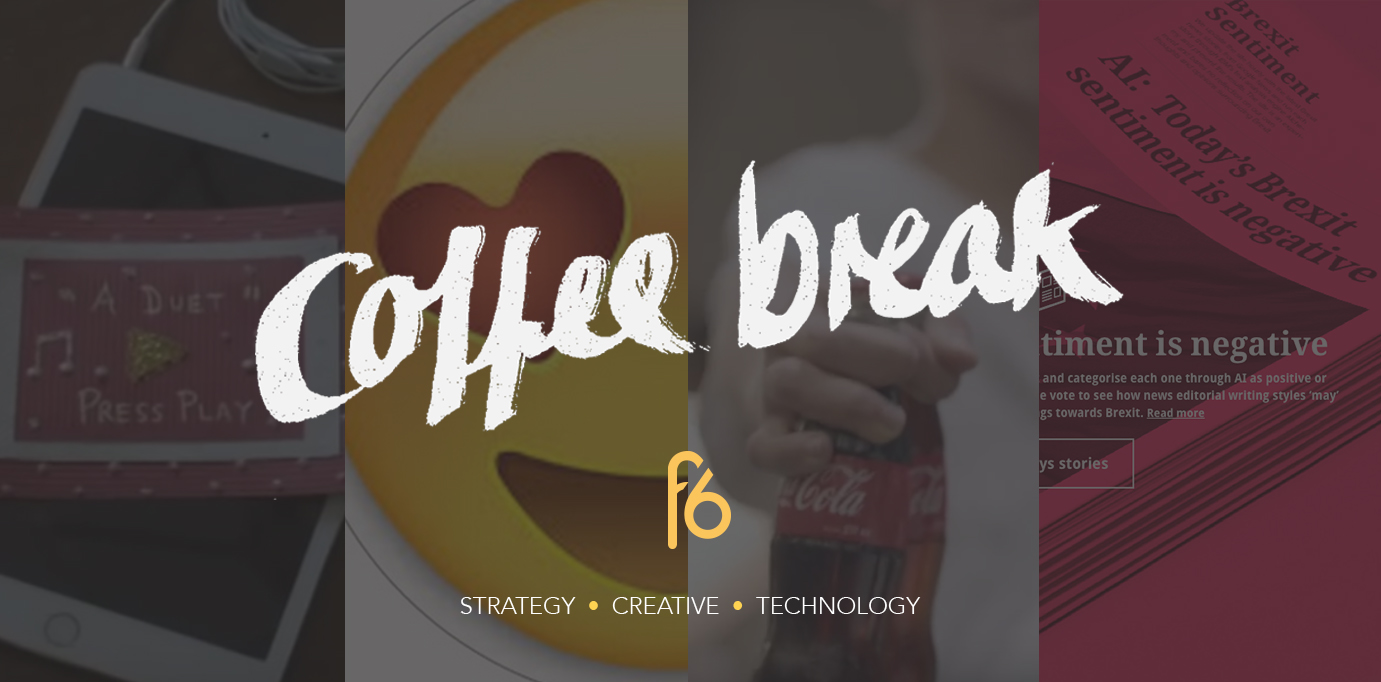Here’s our round-up of what we’ve been talking about this week, from brand storytelling, emojis, and 56 vases of grey, to the difference between falling in love and being in love in marketing.
Candice, Managing Director
Every brand has a story. What’s yours?
The best advice I’ve been given, is to never sell. Always be authentic. It’s important to be yourself and find your voice. As cliché as it might sound, people buy people.
Tell a relatable story that resonates with your target audience, rather than “Buy my stuff… Buy my stuff now” When you tell a story, people will remember it and will relate you and your brand to that story.
Aim to make a connection with your audience. Powerful storytelling can help drive and boost the success of your content marketing.
Examples of some successful storytelling campaigns:
Did this one give you a lump in your throat? Well even if it didn’t, I’m sure you will remember it the next time you pick up a GoPro. Amazing how they didn’t go into any detail about the product, they didn’t give a list of features, or even show the product. They decided to show the product in action in a compelling way. Clever? Firefighter saves the day and it fits perfectly with the GoPro tagline: “Be a Hero”
Apple has a branding strategy that focuses on emotions. They are great at telling their story with how the product experience makes you feel. In this ad they showcase the girl using Apple to digitise an old recording of her grandmother’s song, using Garage Band. She then creates a duet with her own voice, to give to her grandmother on Christmas day. Who doesn’t love Apple?
There are a few examples out there, but the key point is that crafting a compelling story around a product or service is a winning strategy.
Elena, Account Executive
The secret power of emojis
This week I discovered something amazing: http://emojipedia.org. A directory where you can search for any emoji, learn the meaning, and see how it displays in different platforms and operating systems (you can’t imagine how excited I got when I discovered this). So today I’m writing about something that fascinates me: emojis ✌️. My colleagues at F6 have been waiting for months for me to write about this, so I hope my post meets their expectations.
I remember the ad for the first Nokia phone that had a camera. It was a man that travelled to an Asian country and didn’t speak the language, so he took his phone out of his pocket and showed the local people a picture of a toilet. They understood exactly what he needed. The ad was shocking at the time as no phone was able to do that. This meant you could use the phone to communicate with people through pictures. It tapped into the old saying: a picture is worth a thousand words. In this case, more than a thousand words in any language in the word. The same happens today with emojis.
But why am I so obsessed with them and why are they important for marketing?
The use of emojis is increasing every day, people use them to express feelings, or give emotional context to a sentence (for example to show embarrassment 🙈 or sarcasm 😂). A report published by Instagram states that emojis account for nearly half of all the text shared on the platform 😱!
Marketers have tried to use emojis to measure sentiment towards a campaign or piece of content. An example of this is the new Facebook reactions feature. Others have tried to integrate them in their campaigns. Some have been successful, such as Dominos’, where you could order a pizza by texting a pizza emoji 🍕, and some have failed, such a McDonalds:
But what excites me about emojis is how you can add feeling to your posts to communicate with your audience in a more genuine way.
If you think emojis are just for millennials, or they wouldn’t fit with your brand, have a look at this amazing GE initiative.
And if you’re still skeptic about the power of emoji, take a look at this real-time emoji tracker (This blew my mind).
If you’re interested in the story of emoji, you’re in luck! There’s a whole book explaining everything about it: The Story of the Emoji.
Sian, Creative Artworker
What do you get when you merge social commentary & data visualisation?
56 vases and a bright pink landing page.
Both these things are the result of projects that are using data to provide a visual social commentary.
The first project is based on the blue-green porcelain Ru ware, requested by Emperor Huizong of the Northern Song Dynasty after a dream, and is said to be the colour of sky after rain. 700 years after the fall of the Song Dynasty, the project asks what the iconic glaze would look like based on the colour of China’s skies today. Using photographs of Beijing over three years, student Yijin Huo compiled colour swatches that were then used to glaze 53 vases. Displayed along with weather information and particle count, the vases range from light blue to a shocking deep brown. The project is most interesting in that it successfully translates observational data into a conceptual based visual, whilst also providing a scathing comment on China’s worsening environmental problems.
Brexit Sentiment on the other hand uses a digital platform to make its social comment. The site tracks news articles talking about Brexit and analyses them for sentiment and emotion. The AI crawls through the articles looking for specific EU referendum based keywords linked to emotions. Counting up the use of positive, negative, or neutral words, each article is given a positive, negative, or neutral rating, after which a conclusion is drawn regarding the majority feeling towards Brexit for that day. Go to the landing page and you’ll either be presented with text declaring that ‘today’s sentiment is positive’ or ‘today’s sentiment is negative’.
Both of these projects use data to present a visual social commentary, but what’s exciting is that they do so in very different ways, showing the scope of design solutions and applications for data visualisation.
Jacob, PR & Social Media
Does love have a place in marketing?
Having recently discovered what may be my favourite Reddit post of all time, I’ve begun following David Michael Christopher, a Marketing Director for a Pinterest app who believes that commercial marketing and man’s capacity for love go hand in hand.
In his blogpost Love and Marketing, David delivers a call to action like no other: he implores us to love our brand first, pouring ourselves into the crafting of its story and presentation rather than fall into the trap of letting the masses mould us. This doesn’t mean that we should disregard analytics and ignore trends in the customer base – rather, there should be a marriage of what we as marketers want to paint a picture of and what the customer wants.
Comparing the marketer-customer interplay to a romantic relationship, David believes that marketing failure results from a focus on ‘falling in love’ – too heavily focusing on acquiring leads for sales and face value attraction. On the other hand, marketing success is born from ‘being in love’ – a meticulous and passionate construction of the customer’s full journey: ‘from stranger, to lead, to customer and ultimately to advocate.’ A brand that nurtures will invoke desire in customers without them even considering the alternatives.
A great example of this can be seen in Disney World: the twenty million or so visitors each year don’t consider how Disney weighs up against the multitude of alternative holiday destinations, because ‘they have an emotional connection to the Disney brand, to the characters and stories that inhabit that world’. This, I think, is what we should aim for.
Coke’s 2015 ad ‘El SMS’ is another fantastic instance of loving first – especially considering the ad is literally about love. They have an exceptional ability to capture the human experience and ‘create’ memories that we can all identify with, without taking away from or overselling their product.
https://www.youtube.com/watch?v=WTm1Qas2ti0
Don’t just entice customers to fall in love with the brand – make them want to stay in love. Within the current zeitgeist of inbound marketing and conversational, engaging relationships with customers, I believe this approach has never been more relevant.







